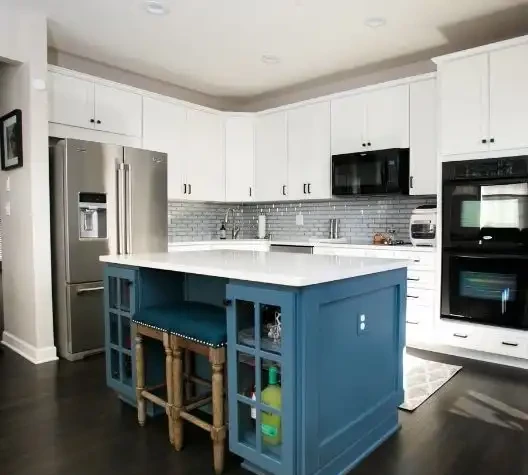Do you have a dated 80s kitchen? One from the 90s with orange oak cabinets? Or are your cabinets a style you loved 10 years ago, but can’t stand today? If you’re ready for a major change, but don’t have the budget for a total renovation, there’s good news. The cost of cabinet refacing is just a fraction of a complete cabinet remodel and will make your cabinets look brand new.
In fact, thanks to the lower cost, more and more homeowners are opting to reface their kitchen cabinets instead of replacing them. This gives the cabinets and the whole kitchen an entirely different feel – one that’s fresh and elevated.
Choosing cabinet refacing also means there might be money left over for upgrades, like soft-close hinges, crown molding at the top of your cabinets, the wine rack you’ve always wanted, or the pull-out garbage and recycle bin cabinet that is so convenient.
The question is: just how much does refacing your cabinets cost – and what goes into the price? Here’s what you need to know, so you can make an informed choice for your kitchen, your home, and your budget.
Cabinet Refacing vs. Replacing: 4 Factors Impacting Cost
On average, according to Home Guide, the average cost for refacing kitchen cabinets is $6,518. A full replacement, on the other hand, is $25,000 to $30,000 or more for custom cabinets depending on the size of the kitchen. As a result, you can get cabinets that look like they were just delivered from the factory at half the cost of a replacement. This is critical if you’re a cost-conscious homeowner.
Why such a big difference? A few factors, including the following.
#1: Less Material is Needed
When you reface rather than replace your cabinets, less material is needed for the job. The doors and drawer fronts are replaced with the new ones you pick based on your design and color preferences. The cabinet boxes stay where they are and are simply painted or stained to match. This requires fewer materials resulting in lower costs.
#2: Lower Labor Costs
The cost of labor will depend heavily on your geographic location. For instance, large, urban areas tend to have higher labor costs than rural or suburban locations. However, refacing is generally far less expensive since the job isn’t as intensive. With refacing you don’t have to pay for demolition or space reconfiguration which can often lead to expensive issues like leveling the floor or moving plumbing or electrical. Additionally, you save on the cost of installing new cabinet boxes.
#3: No Hidden Costs
When you remodel your kitchen, not only is the job more labor and time intensive, there’s the chance for more surprises along the way. This can lead to a big hit to your budget.
For instance, when you tear out old cabinets, there might be damage done to floors or walls that needs to be repaired. Plus, if the footprint of your new cabinets are smaller, then the flooring will have to be extended. It’s a more complex process filled with the potential for unwanted surprises along the way.
With cabinet refacing, you don’t have to worry about any of these unexpected costs. As long as your cabinets are structurally sound and you like the overall configuration of your kitchen, the road to refacing is simple and straightforward. You will get beautifully transformed cabinets without headaches, hassles, and costly surprises.
#4: Faster Turnaround
If you replace your kitchen cabinets, there are many more issues to consider, like adjusting the position of the light fixtures and outlets, as well as investing in new countertops and backsplash. These costs add up fast, especially with today’s high inflation.
With refacing, though, you can keep your counters intact and don’t have to worry about rewiring or reworking anything. This all adds up to a much faster turnaround, with new-looking cabinets in just a few days.
Other Cabinet Refacing Considerations Impacting Cost
When you choose cabinet refacing, you’ll definitely save over the cost of new cabinets. However, there are some variables that can affect the final cost of your projects. One of those is the number of cabinets in your kitchen. A smaller, more compact kitchen will obviously cost less than a larger space with more cabinets.
In addition, decisions regarding hardware, crown molding, glass inserts on cabinets, under-cabinet lighting, and other add-ons will impact the final price tag of your cabinet refacing project. However, in most cases, regardless of your design choices, refacing your cabinets will be far less expensive than a full tear-out and renovation.
Plus, when you opt to reface instead of replace, you can keep your high-quality cabinet boxes in tact. Cabinets made today aren’t as durable or long-lasting as those produced decades ago. If you have solid hardwood cabinets that are in good condition, refacing them allows you to maintain the integrity of the boxes, which is a win for your budget and your home value.


